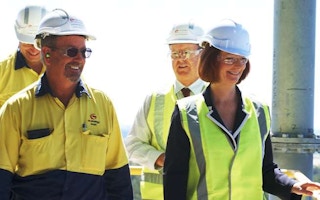Australian prime minister Julia Gillard today announced the approval of a $104.7 million project to integrate solar energy into one of Queensland’s largest fossil fuel power stations.
The 750 megawatt (MW) coal-fired Kogan Creek Power Station in South West Queensland will be integrated with a new 44 MW solar thermal system, making it the largest project of its kind in the world.
The project, called the Kogan Creek Solar Boost project, will use concentrated solar power technology from French firm AREVA Solar to convert the sun’s energy into super-heated steam which will drive the plant’s turbines along with steam from burning coal. Areva Solar acquired the solar technology, called the Compact Linear Fresnel Reflector (CLFR), when it bought Australian firm Ausra last year.
The world’s first solar/coal hybrid facility, called Cameo Station, was opened last July in Colorado in the United States. The project, valued at $4.5 million, was a demonstration project that used a different concentrated solar technology to Areva’s, this one based on solar troughs. Carbon emissions reductions were estimated at two to five per cent, although project managers are targeting ten per cent in future operations.
Kogan Creek Power Station is owned by CS Energy, a Queensland government-owned corporation that owns and operates four Queensland power stations.
CS Energy chief executive David Brown said, “Already Kogan Creek Power Station is one of the largest and most energy efficient power stations in Australia’s electricity market. By using energy from the sun, we will increase the station’s capacity to meet the growing demand for electricity, increase its fuel efficiency and reduce its greenhouse intensity – avoiding the production of 35,600 tonnes of greenhouse gases annually.
“In simple terms, the solar addition will enable Kogan Creek Power Station to produce more electricity with the same amount of coal,” he added.
Use of the solar thermal technology will provide enough extra electricity to power up to 5,000 Australian homes annually. The amount of emissions saved is the equivalent of taking 11,000 cars off the road for one year.
Construction of the solar integration project will begin in the first half of this year and will be completed in 2013.
CS Energy is providing $70 million for the project, $35.4 million of which has been redirected from a contribution by the Queensland Government to CS Energy’s Carbon Reduction Program. The Australian Government’s Renewable Energy Demonstration Program is contributing over $34 million.
With the impending carbon tax set to be enacted in July 2012, Australia’s power companies are still waiting for details of how their industry will be affected. The Sydney Morning Herald reported last month that Ross Garnaut, the government’s chief climate change adviser, said no compensation would be needed for coal-powered electricity producers. But the same report also mentioned that the government would likely provide compensation in order to prevent plant closures and job losses.
Irregardless of whether or not compensation is provided, power companies are looking for ways to increase their energy efficiency and reduce their vulnerability to a carbon tax.
Mr Brown said, “Projects like this are essential for CS Energy to successfully transition to a low-carbon future and will build the capacity of the Australian solar industry.”










